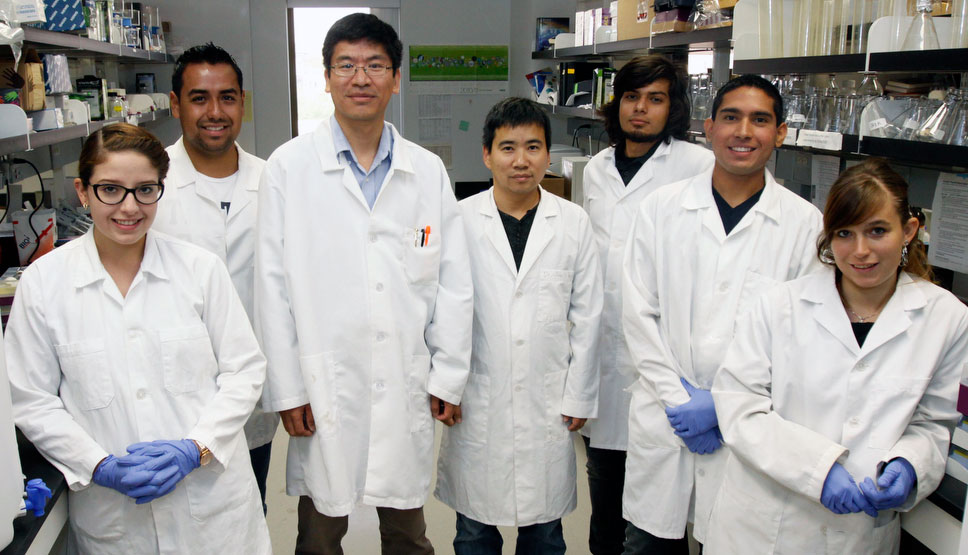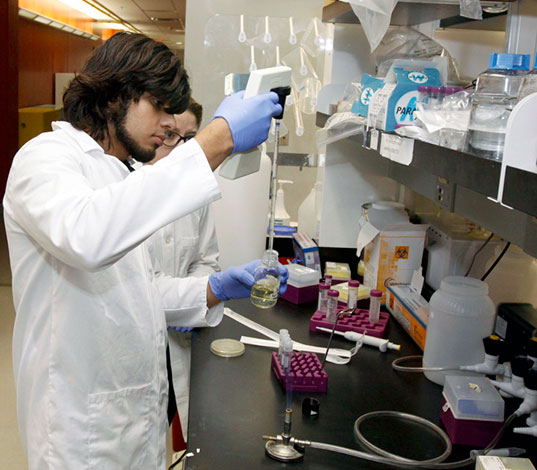Originally published September 26, 2014
By Nadia M. Whitehead
UTEP News Service
When someone becomes infected with Bacillus anthracis, or anthrax, swarms of bacteria quickly replicate and unsheathe their weapons – toxins. These are what attack and ultimately kill the body.

But what if these deadly toxins could be rendered harmless? That’s the goal of Jianjun Sun, Ph.D., a biologist at The University of Texas at El Paso who has received more than $1 million from the National Institutes of Health (NIH) for his research. In search of a way to disrupt the destructive process, he and his lab team analyze how the toxins infiltrate and kill healthy cells one by one.
“If we can figure out how the toxin works at the molecular level and see which key portion is responsible for killing cells, we could design a drug to block the action,” Sun said.
While effective antibiotics against the bacteria exist, there are no drugs that can stop the harmful toxins they release. This is why it is so hard to survive anthrax. By the time a patient is diagnosed, it’s usually too late; they have reached the “point of no return,” where toxin levels within the system are perilously high.
But UTEP researchers have noticed a crucial trigger that decides whether or not anthrax toxins will be successful when they wage war, doctoral biology student Pedro Jacquez says.
Normally, when an anthrax toxin attacks, it first binds to a specific receptor on the surface of the cell before it can breach the cell’s protective barrier, the membrane. Once this bond is formed, the toxin gets drawn inside the cell and begins to create a hole, or pore, on the membrane. This key move — the crack in the fortification — marks the end of the cell; it allows additional toxic enzymes to enter, throwing the whole cell into disarray and causing it to die.
But Sun discovered the break in the membrane can be stopped from forming, thereby halting the invasion of the other lethal toxins.
“There’s a trigger for all this action,” he said. The team calls it a disulfide bond. It sits within the cell receptor to which the toxin binds, and can act like an on and off switch.
“In the presence of this disulfide bond, the toxin functions perfectly,” the biologist said. “But if we break the disulfide bond, all the action is stopped and the toxin cannot do damage.”
So far, the research team has genetically modified receptors to lack the disulfide bond, which is how they know it’s crucial for the toxin’s success. Now, they are in search of a specific chemical compound that can turn off the naturally occurring bond. When they find the chemical, it could potentially be used as a drug if someone becomes infected with anthrax. It would work by shutting off the receptors’ disulfide bonds, thus stopping the toxins from doing any damage.

Jacquez, who has been working in Sun’s lab since 2010, is focusing on this molecular process for his dissertation. Knowing a broken disulfide bond stops the toxin from killing the cell, he wants to examine more of the specifics: What exactly does breaking the bond do? How does it stop the attack process?
Jacquez described the anthrax toxin as morphing into different shapes — he likes to refer to movie Transformers when he explains the process; how the yellow Camaro, Bumblebee, can change into a robot. Similarly, once the toxin binds and gets drawn into the cell, it takes on a pumpkin shape. But to create the crack in the cell’s barrier, it transforms into a mushroom shape, with the stem attaching to the cell’s wall and acting as a tunnel through which toxins outside the cell can swim.
But does turning off the disulfide bond block this tunnel or is another mechanism behind breaking the bond what is inhibiting the invasion? He thinks he knows the answer, but that, he says, will have to wait until he’s defended his dissertation later this year. He also doesn’t want to leak the details before they publish their findings in a journal.
In the meantime, he and Sun plan to test a slew of chemicals to see which can turn off the trigger. They admit creating a drug to fight anthrax will be a long and arduous process; they also think they are onto something big.